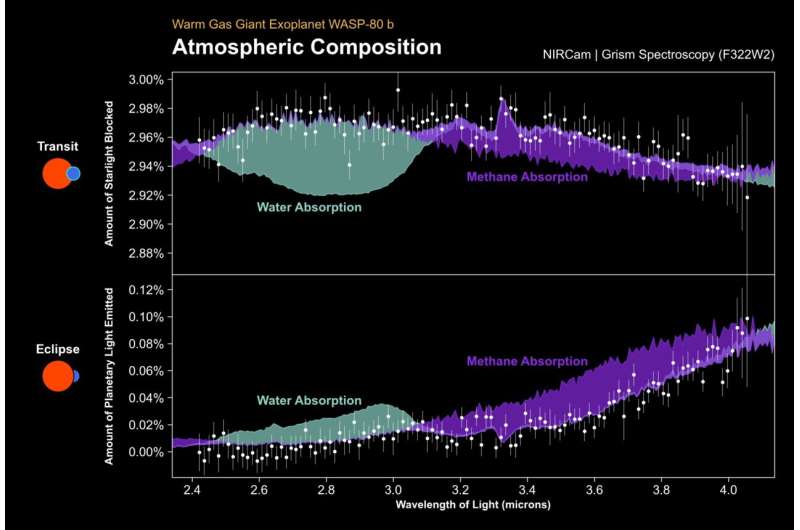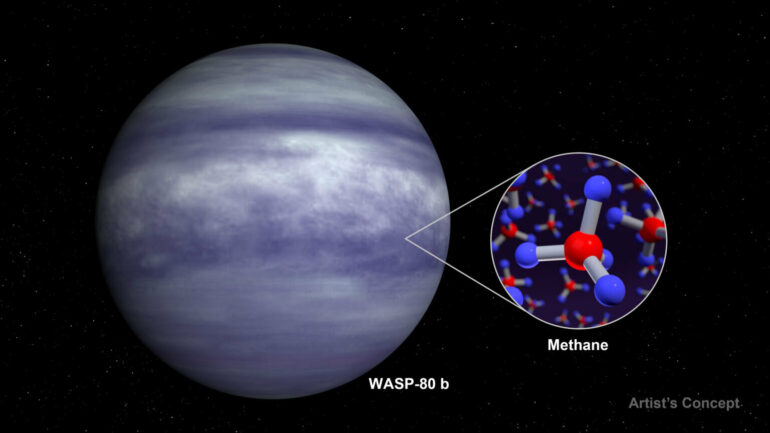The James Webb Space Telescope observed the exoplanet WASP-80 b as it passed in front of and behind its host star, revealing spectra indicative of an atmosphere containing methane gas and water vapor. While water vapor has been detected in over a dozen planets to date, until recently, methane—a molecule found in abundance in the atmospheres of Jupiter, Saturn, Uranus, and Neptune within our solar system—has remained elusive in the atmospheres of transiting exoplanets when studied with space-based spectroscopy.
Taylor Bell from the Bay Area Environmental Research Institute (BAERI), working at NASA’s Ames Research Center in California’s Silicon Valley, and Luis Welbanks from Arizona State University tell us more about the significance of discovering methane in exoplanet atmospheres and discuss how Webb observations facilitated the identification of this long-sought-after molecule. These findings were recently published in Nature.
“With a temperature of about 825 Kelvin (about 1,025 degrees Fahrenheit), WASP-80 b is what scientists call a ‘warm Jupiter,’ which are planets that are similar in size and mass to the planet Jupiter in our solar system but have a temperature that’s in-between that of hot Jupiters, like the 1,450-K (2,150-F) HD 209458 b (the first transiting exoplanet discovered), and cold Jupiters, like our own which is about 125 K (235 F).”
“WASP-80 b goes around its red dwarf star once every three days and is situated 163 light-years away from us in the constellation Aquila. Because the planet is so close to its star and both are so far away from us, we can’t see the planet directly with even the most advanced telescopes like Webb. Instead, researchers study the combined light from the star and planet using the transit method (which has been used to discover most known exoplanets) and the eclipse method.”
“Using the transit method, we observed the system when the planet moved in front of its star from our perspective, causing the starlight we saw to dim a bit. It’s kind of like when someone passes in front of a lamp, and the light dims.”
“During this time, a thin ring of the planet’s atmosphere around the planet’s day/night boundary is lit up by the star, and at certain colors of light where the molecules in the planet’s atmosphere absorb light, the atmosphere looks thicker and blocks more starlight, causing a deeper dimming compared to other wavelengths where the atmosphere appears transparent. This method helps scientists like us understand what the planet’s atmosphere is made of by seeing which colors of light are being blocked.”
“Meanwhile, using the eclipse method, we observed the system as the planet passed behind its star from our perspective, causing another small dip in the total light we received. All objects emit some light, called thermal radiation, with the intensity and color of the emitted light depending on how hot the object is.”
“Just before and after the eclipse, the planet’s hot dayside is pointed toward us, and by measuring the dip in light during the eclipse, we were able to measure the infrared light emitted by the planet. For eclipse spectra, absorption by molecules in the planet’s atmosphere typically appears as a reduction in the planet’s emitted light at specific wavelengths. Also, since the planet is much smaller and colder than its host star, the depth of an eclipse is much smaller than the depth of a transit.”

The measured transit spectrum (top) and eclipse spectrum (bottom) of WASP-80 b from NIRCam’s slitless spectroscopy mode on NASA’s James Webb Space Telescope. In both spectra, there is clear evidence for absorption from water and methane whose contributions are indicated with colored contours. During a transit, the planet passes in front of the star, and in a transit spectrum, the presence of molecules makes the planet’s atmosphere block more light at certain colors, causing a deeper dimming at those wavelengths. During an eclipse, the planet passes behind the star, and in this eclipse spectrum, molecules absorb some of the planet’s emitted light at specific colors, leading to a smaller dip in brightness during the eclipse compared to a transit. Image © BAERI/NASA/Taylor Bell.
“The initial observations we made needed to be transformed into something we call a spectrum; this is essentially a measurement showing how much light is either blocked or emitted by the planet’s atmosphere at different colors (or wavelengths) of light. Many different tools exist to transform raw observations into useful spectra, so we used two different approaches to make sure our findings were robust to different assumptions.”
“Next, we interpreted this spectrum using two kinds of models to simulate what the atmosphere of a planet under such extreme conditions would look like. The first type of model is entirely flexible, trying millions of combinations of methane and water abundances and temperatures to find the combination that best matches our data. The second type, called ‘self-consistent models,’ also explores millions of combinations but uses our existing knowledge of physics and chemistry to determine the levels of methane and water that could be expected.”
“Both model types reached the same conclusion: a definitive detection of methane.”
“To validate our findings, we used robust statistical methods to evaluate the probability of our detection being random noise. In our field, we regard the ‘gold standard’ to be something called a ‘5-sigma detection,’ meaning the odds of detection being caused by random noise are 1 in 1.7 million. Meanwhile, we detected methane at 6.1-sigma in both the transit and eclipse spectra, which sets the odds of a spurious detection in each observation at 1 in 942 million, surpassing the 5-sigma ‘gold standard,’ and reinforcing our confidence in both detections.”
“With such a confident detection, not only did we find a very elusive molecule, but we can now start exploring what this chemical composition tells us about the planet’s birth, growth, and evolution. For example, by measuring the amount of methane and water in the planet, we can infer the ratio of carbon atoms to oxygen atoms.”
“This ratio is expected to change depending on where and when planets form in their system. Thus, examining this carbon-to-oxygen ratio can offer clues as to whether the planet formed close to its star or farther away before gradually moving inward.”
“Another thing that has us excited about this discovery is the opportunity to finally compare planets outside of our solar system to those in it. NASA has a history of sending spacecraft to the gas giants in our solar system to measure the amount of methane and other molecules in their atmospheres. Now, by having a measurement of the same gas in an exoplanet, we can start to perform an ‘apples-to-apples’ comparison and see if the expectations from the solar system match what we see outside of it.”
“Finally, as we look toward future discoveries with Webb, this result shows us that we are at the brink of more exciting findings. Additional MIRI and NIRCam observations of WASP-80 b with Webb will allow us to probe the properties of the atmosphere at different wavelengths of light. Our findings lead us to think that we will be able to observe other carbon-rich molecules such as carbon monoxide and carbon dioxide, enabling us to paint a more comprehensive picture of the conditions in this planet’s atmosphere.”
“Additionally, as we find methane and other gases in exoplanets, we will continue to expand our knowledge about how chemistry and physics work under conditions unlike what we have on Earth, and maybe sometime soon, in other planets that remind us of what we have here at home. One thing is clear——the journey of discovery with the James Webb Space Telescope is brimming with potential surprises.”
More information:
Taylor Bell, Methane throughout the atmosphere of the warm exoplanet WASP-80b, Nature (2023). DOI: 10.1038/s41586-023-06687-0. www.nature.com/articles/s41586-023-06687-0
Citation:
Webb identifies methane in an exoplanet’s atmosphere (2023, November 22)



